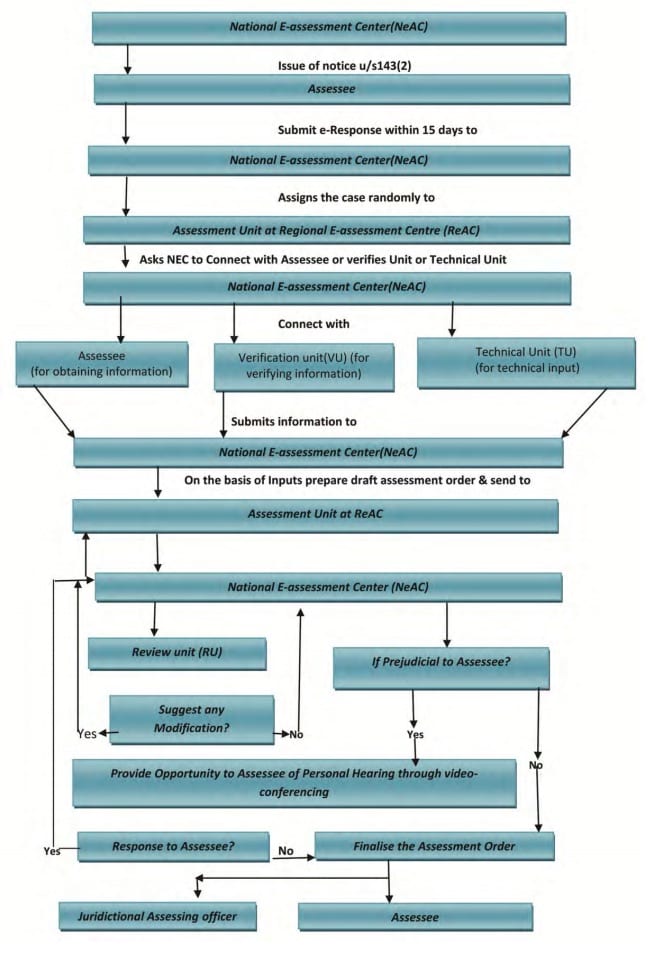Pros and cons of E-Proceeding
Structure of E-Proceeding
NeAC (National E-assessment Center) will be the top body to send all the notices and communication electronically. There are eight regional e-assessment centers (ReACs) in Delhi, Mumbai, Chennai, Kolkata, Ahmedabad, Pune, Bengaluru and Hyderabad. Under these centers, there would be four units – technical, review, assessment and verification. The assessment unit would identify issues, seek information and analyze material to frame draft assessment orders. The verification unit would conduct inquiry, examine books of account, examine witnesses and record statements through videoconferencing. The technical unit would provide advice on legal, accounting, forensic, information technology, valuation, transfer pricing, and data analytics issues. The review unit would review the draft assessment order – whether material evidence is brought on record, points of facts and law are incorporated, application of judicial decisions is considered and the arithmetic correctness. NeAC would assign cases to the assessment unit, verification unit and technical unit through an automated allocation system. It would then select draft assessment orders for review and allocate it to the review unit through an automated allocation system. NeAC would provide an opportunity to the taxpayer concerned before finalizing the order. After finalizing the assessment order, it would transfer all electronic records to the jurisdictional Assessing Officer for post assessment work such as collecting penalty. Taxpayers will receive notices on their registered email addresses and mobile numbers. Each notice or any form of communication from the IT department will hold a document identification number (DIN). All replies to the notices from the IT department have to be made electronically in the account in the e-filing portal and not personally or through post (unless it is an exceptional case). Assesses would have 15 days to respond to the notices. The response shall be considered to be successfully submitted when the individual receives the acknowledgement from the National e-assessment Centre. After receiving a reply from the taxpayer, NeAC will allocate the case to an assessing officer at the regional level through an automated system. Regional assessments requiring assistance from the verification unit or technical assistance from the technical unit shall go through the automated allocation system. If the Regional Assessment Unit requires further information or document from the Assessee, the request will first be made to the National e-assessment centre. A draft assessment order will be sent from the Regional Unit to the National E-assessment centre. In certain cases, personal hearing would be allowed. Hearings of the cases will be conducted exclusively through video links or any other such facility that does not require the Assessee or his/her representative to be physically present. Hopefully, new system will reduce harassment of taxpayers and would not require direct interaction with the Assessee.
Exceptions of E-proceeding
The CBDT also carved out six exceptions where ‘E-proceeding’ facility will not be mandatory. These include:
assessment in the course of search,best judgement,set-aside assessments, non-PAN cases,stations with limited capacity of bandwidth andextraordinary circumstances where administrative difficulties can occur
Procedure after E-assessment
The National e-assessment Centre shall, after completion of the assessment, transfer all the electronic records of the case to the Assessing Officer having jurisdiction over such case for:
a) Imposition of penalty;b) Collection and recovery of demand;c) Rectification of mistake;d) Giving effect to appellate orders;e) Submission of remand report/ any other report to be furnished before CIT(A) or courts;f) Proposal seeking sanction for launch of prosecution and filing of complaint before the Court;
Recommended
Income Tax AssessmentSelf Assessment TaxDepreciation rates as per companies actBelated ReturnList of All Incomes Exempted from Income Tax
Diagrammatic presentation of the New Scheme if E-assessment 2019
